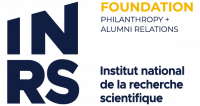Andrés Henao Florez

“For me, this award is, first of all, a recognition of the work I have done over the past two years. It is also a recognition of the support, friendship and knowledge of the people at INRS who have given me the opportunity to step out of my comfort zone and innovate.”
Andrés Henao Florez
M. Sc. in Urban Studies, 2022
Centre Urbanisation Culture Société | Supervisor: Phillipe Apparicio
Andrés Henao Florez chose to conduct a project on the dangerous overtaking of cyclists by motor vehicles in Montréal. This research took the form of a master's thesis including two scientific articles. The first publication deals with the analysis of the explanatory factors of dangerous overtaking of cyclists by motor vehicles on the island of Montréal. In this article, a model was constructed to analyse the probability that a cyclist will undergo a dangerous overtaking (less than one metre). This probability increases if he or she is riding on a major road, on a road with parked vehicles and the longer the passing time. The second publication describes the development of a low-cost open source sensor called one metre plus (1m+) which he created and which is capable of measuring the lateral passing distance, recording the geographical position and recording a video of the journey. The plans, codes and schematic design are open and therefore easily accessible to the scientific community. This project aims to democratise DLD research and develop a participatory platform/project that offers tools to researchers worldwide. This product is the result of his programming, design and engineering skills acquired throughout his academic career, and of the knowledge on cyclist safety and urban form acquired during his studies for his Master's degree in Urban Studies.
What brought you to INRS? What do you remember about your experience?
Following my bachelor's degree in Mechanical Engineering, I worked in innovation laboratories to develop various projects related to technological education, community knowledge transfer and sustainable urban mobility. In 2018, I worked on the restructuring of the National Soil Museum of Colombia, where I discovered the importance of geography and urban planning in urban mobility and environmental equity issues. My curiosity for alternative modes of transport, and more specifically for the bicycle, has grown over the years. I wanted to broaden my knowledge of mobility and social science methodologies. After researching university programs in Quebec, I found the team at the Environmental Equity Laboratory (LAEQ) led by Philippe Apparicio. Incredibly, the LAEQ's research lines brought together many of my scientific interests.
On a personal level, being part of INRS has been a very rewarding experience, as I was able to apply my engineering skills in different fields and exchange knowledge in a multidisciplinary environment with students from different backgrounds, often completely using innovative research methodologies/strategies. Furthermore, I am grateful to have had the chance to work under the guidance of Philippe Apparicio whose expertise and unconditional support have marked my personal and academic journey in Québec.
Can you describe the issue and impact of the research presented in your master's thesis?
I chose to carry out a project on dangerous overtaking of cyclists by motor vehicles in Montreal. This research took the form of a master's thesis comprising two scientific articles. The first publication deals with the analysis of the explanatory factors of dangerous overtaking of cyclists by motorized vehicles on the island of Montreal. In this article, a model was constructed to analyze the probability that a cyclist will undergo a dangerous overtaking (less than one metre). This probability increases if he or she is riding on a major road, on a road with parked vehicles and the longer the passing time. The second publication describes the development of a low-cost open source sensor called one metre plus (1m+) that I created and which is able to measure the passing lateral distance, record the geographical position and record a video of the journey. The plans, codes and schematic design are open and therefore easily accessible to the scientific community. This project aims to democratize DLD research and develop a participatory platform/project that offers tools to researchers worldwide. This product is the result of my programming, design and engineering skills acquired throughout my academic career, and of the knowledge on cyclist safety and urban form acquired during my master's degree in urban studies.
What does winning this award mean to you?
For me, this award is, first of all, a recognition of the work I have done over the last two years. It is also an acknowledgement of the support, friendship and knowledge of the people at INRS who have given me the opportunity to step out of my comfort zone and innovate. This award is also a way to show my work and commitment to my family in Colombia and to encourage the work of foreign students who often face various systemic barriers. Finally, this award is one of the many ways in which INRS contributes to the outreach of its community members, these institutional initiatives open the door for my colleagues in the South to access quality education.
What is the next chapter for you now that you have graduated?
In the next few years, I hope to complete my PhD project, which aims to determine the risk factors for cyclists in my home city, Bogotá. I hope that the project can help policy makers and planners to improve conditions for cyclists and encourage more sustainable forms of mobility. I also hope to contribute to the realization of products and methodologies that improve the quality of life of people in the context of the global north and south. On a more personal level, I wish to continue my research work and realize my dream of becoming a professor. I am aware that this is a long way off, but my training and work with various research groups strengthen my will to pass on my knowledge and learn from others.
